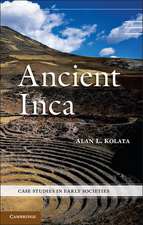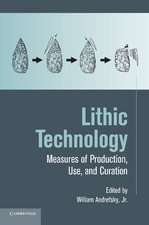Stone Tools in Human Evolution: Behavioral Differences among Technological Primates
Autor John J. Sheaen Limba Engleză Hardback – 6 noi 2016
| Toate formatele și edițiile | Preț | Express |
|---|---|---|
| Paperback (1) | 239.55 lei 3-5 săpt. | +21.78 lei 6-10 zile |
| Cambridge University Press – 6 noi 2016 | 239.55 lei 3-5 săpt. | +21.78 lei 6-10 zile |
| Hardback (1) | 704.91 lei 6-8 săpt. | |
| Cambridge University Press – 6 noi 2016 | 704.91 lei 6-8 săpt. |
Preț: 704.91 lei
Preț vechi: 819.66 lei
-14% Nou
Puncte Express: 1057
Preț estimativ în valută:
134.90€ • 139.36$ • 112.27£
134.90€ • 139.36$ • 112.27£
Carte tipărită la comandă
Livrare economică 26 martie-09 aprilie
Preluare comenzi: 021 569.72.76
Specificații
ISBN-13: 9781107123090
ISBN-10: 1107123097
Pagini: 306
Ilustrații: 51 b/w illus. 26 tables
Dimensiuni: 182 x 260 x 15 mm
Greutate: 0.72 kg
Editura: Cambridge University Press
Colecția Cambridge University Press
Locul publicării:New York, United States
ISBN-10: 1107123097
Pagini: 306
Ilustrații: 51 b/w illus. 26 tables
Dimensiuni: 182 x 260 x 15 mm
Greutate: 0.72 kg
Editura: Cambridge University Press
Colecția Cambridge University Press
Locul publicării:New York, United States
Cuprins
List of figures; List of tables; List of boxes; Preface; Acknowledgments; Introduction. Little questions vs big questions; 1. Why archaeologists misunderstand stone tools; 2. How we know what we think we know about stone tools; 3. Describing stone tools; 4. Stone cutting tools; 5. Logistical mobility; 6. Language and symbolic artifacts; 7. Dispersal and diaspora; 8. Residential sedentism; 9. Conclusion; Appendix 1. Traditional age-stages and industries; Glossary; Bibliography; Index.
Recenzii
'A useful counterbalance to hidebound Paleolithic systematics, Stone Tools in Human Evolution implements a better-grounded descriptive approach. It shows a way forward and therefore deserves close study.' Current Anthropology
'Designed for a readership of upper-division college and first-year archaeology graduate students (with 'boxes', plenty of line drawings, and a glossary of terms), but with a distinct message for all those who think about and research human evolution - biological and cultural - this interesting book has a valuable message. It is full of thought-provoking and sometimes provocative ideas.' Journal of Anthropological Research
'Designed for a readership of upper-division college and first-year archaeology graduate students (with 'boxes', plenty of line drawings, and a glossary of terms), but with a distinct message for all those who think about and research human evolution - biological and cultural - this interesting book has a valuable message. It is full of thought-provoking and sometimes provocative ideas.' Journal of Anthropological Research
Notă biografică
Descriere
An exploration of how the evolution of behavioral differences between humans and other primates affected the archaeological stone tool evidence.











